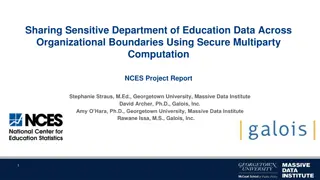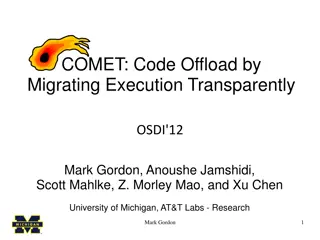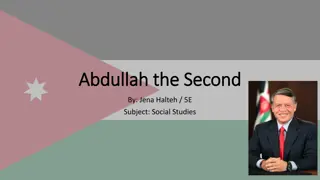Theory of Computation Introduction: Dr. Abdulhussein M. Abdullah
Delve into the theory of computation with Dr. Abdulhussein M. Abdullah in the 2nd semester of 2017-2018. Explore the fundamental questions regarding what can be computed, computational problems, and the representation of information. Gain insights into computational models and computability, complexity, and practical computing devices and systems through this comprehensive introductory lecture.
Download Presentation

Please find below an Image/Link to download the presentation.
The content on the website is provided AS IS for your information and personal use only. It may not be sold, licensed, or shared on other websites without obtaining consent from the author.If you encounter any issues during the download, it is possible that the publisher has removed the file from their server.
You are allowed to download the files provided on this website for personal or commercial use, subject to the condition that they are used lawfully. All files are the property of their respective owners.
The content on the website is provided AS IS for your information and personal use only. It may not be sold, licensed, or shared on other websites without obtaining consent from the author.
E N D
Presentation Transcript
Theory of Computation Introduction 2ndSemester 2017-2018 Dr. Abdulhussein M. Abdullah Lec #1
Three fundamental questions What can be computed? (Computing models and computability) What can be computed efficiently? (Complexity) How can we build practical computing devices and systems? (Architectures and Systems)
Objective Make a theory out of the idea of computation.
What is computation? Processing of information based on a finite set of operations or rules. Paper + Pencil Arithmetic Abacus Calculator w/moving parts (Babbage wheels, Mark I) Ruler & compass geometry constructions Digital Computers
What do we want in a theory? Generality Technology-independent Abstraction: ignores inessential details Precision Mathematical, formal. Can prove theorems about computation, both positive (what can be computed) and negative (what cannot be computed).
Representing Information Alphabet Ex: a, b, c, . . . , z. Strings: finite concatenation of alphabet symbols, order matters Ex: qaz, abbab = empty string (length 0; sometimes e) Inputs (& outputs) of computations are strings.
Computational Problems (i.e. Tasks) A single question that has infinitely many different instances given a string x, does it have an even number of a s? given a string x, does it have more a s than b s?
Examples of computational problems on numbers ADDITION: given two numbers x, y, compute x + y. PRIMALITY: given a number x, is x prime?
Examples of computational problems about computer programs SYNTACTICALLY CORRECT C PROGRAM: given a string of ASCII symbols, does it follow the syntax rules for the C programming language? HALTING PROBLEM: given a computer program (say in C), can it ever get stuck in an infinite loop?
Characteristics of computational problems Discreteness State of the system can be represented as a finite amount of information Abstraction Irrelevant details can be ignored Generality A single mathematical model applies to many devices
The (Mathematical) Idea of a Language Underlying Principle: Whatever can be computed can be written down Alphabet Ex: a, b, c, . . . , z. Strings: finite concatenation of alphabet symbols, order matters Ex: qaz, abbab Language: any set of strings
Computation means solving problems through the mechanical, preprogrammed execution of a series of small, unambiguous steps.
What is computing? First Definition Computing a yes/no answer means Determining if a string is in a language
Theory of computation is the branch that deals with how efficiently problems can be solved on a model of computation, using an algorithm.
A model of computation is an abstract device used to perform computation. A model of computation is the definition of the set of allowable operations used in computation and their respective costs.
Three Basic Concepts 1. languages 2. grammars 3. automata
Language Concepts An alphabet, denoted by , is a finite, nonempty set of symbols. A string is a finite sequence of symbols from the alphabet.
Powers of an alphabet, Ak, is the set of strings of length k with symbols from A. Alphabet: A = {0, 1} A0= { } A1= {0, 1} A2= {00,01, 10, 11}
The set of all strings over A is denoted A* A language L over an alphabet A is a subset of A*. That is, L A*. Examples: The set of legal English words. The set of legal C programs. The set of strings consisting of n 0's followed by n 1's. {01, 0011, 000111, }
The empty language . The language { } consisting of the empty string. { }
Grammar Concepts A grammar G is a quadruple G = (V, T, S, P) where: V is a finite set of objects called variables. T is a finite set of objects called terminal symbols. S V is a special symbol called the start symbol. P is a finite set of productions. V and T are nonempty and disjoint.
Productions have form x y where: x (V T) , i.e., x is some non-null string of terminals and variables. y (V T)*, i.e., y is some, possibly null, string of terminals and variables. w1 wn means that w1derives wn in zero or more production steps.
Mathematical abstractions (models) can be used to represent real systems Formal reasoning can improve our ability to describe, design and build systems > Precisely define requirements >Uncover design flaws > Produce rational implementations Different models and logics have different strengths and weaknesses























